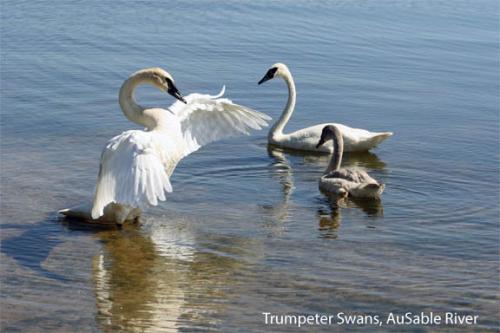Birding is big business for coastal Lake Huron communities
Annual Tawas Point Birding Festival accents how diverse coastal habitats and bird biodiversity in northeast Michigan can enhance sustainable coastal tourism opportunities.

Spring arrives in Michigan, and so do the many birds—from warblers to waterfowl—migrating from their southerly wintering grounds. Great Lakes coastlines provide important migratory corridors where birds utilize the winds of the offshore highway for flight, and cover of shoreline and coastal wetland habitats for shelter and refueling on food. They also offer an opportunity for nature enthusiasts and wildlife watchers to get outside to experience and enjoy these amazing wildlife migrations.
Each spring, in northeast Michigan’s Iosco County, the annual Tawas Point Birding Festival—slated this year for May 15 – 18, 2014—is hosted by the Michigan Audubon in cooperation with AuSable Valley Audubon, Michigan Department of Natural Resources, U.S. Forest Service, along with other community and conservation collaborators. This event attracts visitors from across the state, country, and even internationally—all with a shared interest in birds and birding. Tawas Point State Park—recently designated an Important Bird Area—offers an ideal setting where birdwatchers meet up with the birds during their migration. Such geographic points, or places where land extends out into the lake, offer important resting and refueling points during these migrations, and in the case of Tawas Point, it is the first or last stopping point for birds looking to cross Saginaw Bay. The diverse coastal habitats of this Lake Huron shoreline translate to richness in biodiversity, illustrated by endangered Great Lakes piping plovers nesting along the Tawas Point coastline and the more than 25 warbler species spotted by birders during last year’s festival.
 How many birds can you discover and add to your life list? A visit to the Lake Huron coastline offers abundant opportunities for birding and wildlife watching. Aside from the Tawas Point Birding Festival, additional opportunities you may wish to explore include:
How many birds can you discover and add to your life list? A visit to the Lake Huron coastline offers abundant opportunities for birding and wildlife watching. Aside from the Tawas Point Birding Festival, additional opportunities you may wish to explore include:
- Saginaw Bay is known for its extensive network of coastal wetlands, a mecca for waterfowl and wetland species. Each August, the DNR Saginaw Bay Visitor Center hosts the Saginaw Bay Waterfowl Festival at the Bay City State Recreation Area; and you will want to check out the Saginaw Bay Birding Trail, led in development by the Saginaw Basin Land Conservancy.
- Vast stretches of undistributed Lake Huron coastline at Negwegon State Park and Thompson’s Harbor State Park are known for their diverse habitats and coastal wetlands communities that support biodiversity—a wide variety of plants and animals. Waterfowl and loons, eagles and ospreys, terns and shore birds are among those inhabiting these secluded sandy beaches, dune and swale, cobble shores, and coastal marsh habitats.
- Tuttle marsh in Iosco County offers an easily accessible example of wetland marshes common across Michigan. This large wetland area is home to nesting osprey—aside from Bald Eagles, Northern Harrier ‘Marsh Hawks’, Red-tailed hawks, merlin, and kestrels—all birds of prey witnessed by one birder in just one evening at Tuttle Marsh. This is not to diminish the many other wetland species you can expect to see here, such as various ducks, herons, egrets, rails and the American and Least Bittern.
- Many rare, threatened, and endangered species inhabit northeast Michigan, given the diversity and large areas of protected habitats in this region. Among several, three stand out for both their rarity and their popularity among birders. Along the coastline, shore habitats of Tawas Point are critical and protected for the endangered Great Lakes piping plover. Up river, the famous AuSable River provides home to breeding pairs of Trumpeter Swans. Inland jack pine forests, protected and managed by the U.S. Forest Service across northeast Michigan, serve as critical habitat for the endangered and world-renowned Kirtland’s Warbler.

Birding can mean big business for coastal communities in northern Michigan. Communities can capitalize on a richness of birds and birders to generate economic activity through ecotourism or sustainable coastal tourism opportunities. Participation in birding and wildlife watching across Michigan is a growing industry. The latest national surveys conducted by U.S. Fish and Wildlife Service show wildlife watching participation expanding to some 3,199,000 in 2011 (up from 2,424,000 in 2001), a notable increase in only 10 years’ time. The economic value generated by wildlife watching in Michigan is notable too, in that in 2011, this activity accounted for $1,220,816,000 (expended toward wildlife watching trips and equipment). A recent Sustainable Coastal Tourism Guide, produced by Michigan Sea Grant and Michigan State University Extension, shares values, best practices and examples of how northeast Michigan communities are seeking to promote coastal tourism opportunities in ways that are friendly to the environment.
Learn more about Great Lakes coastal habitats and the importance of promoting biodiversity by visiting the Michigan Sea Grant website; and start your birding journey today with the Tawas Point Birding Festival—more about their schedule of events is available online.
Visiting coastal northeast Michigan? Plan your trip by visiting the U.S. 23 Huron Shores Heritage Route website at http://www.us23heritageroute.org/



 Print
Print Email
Email

